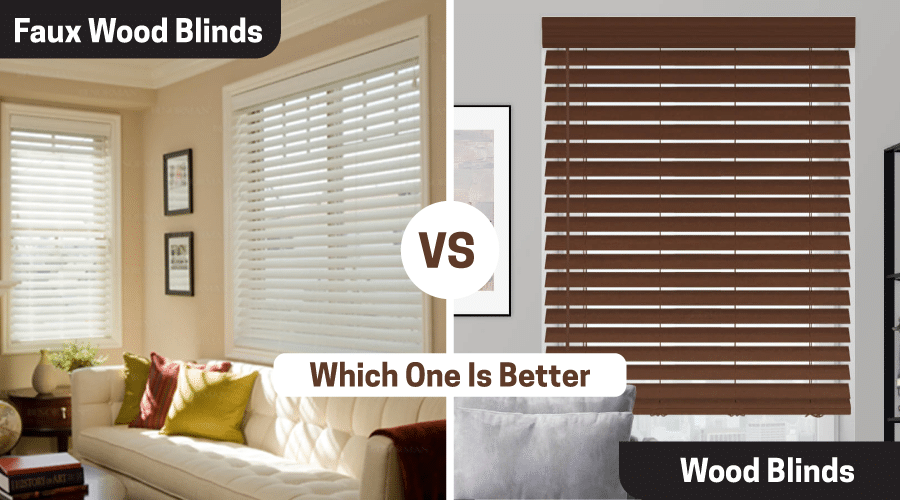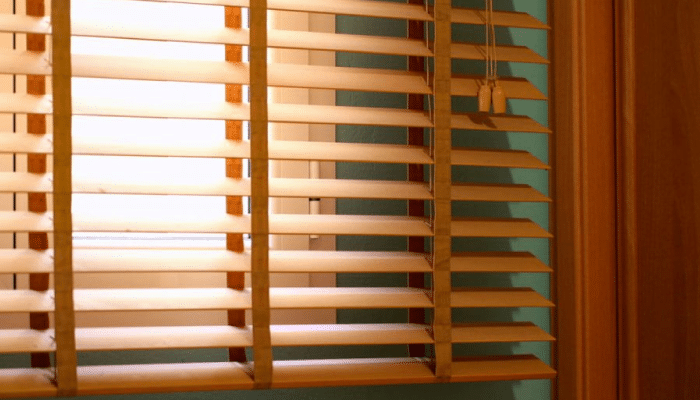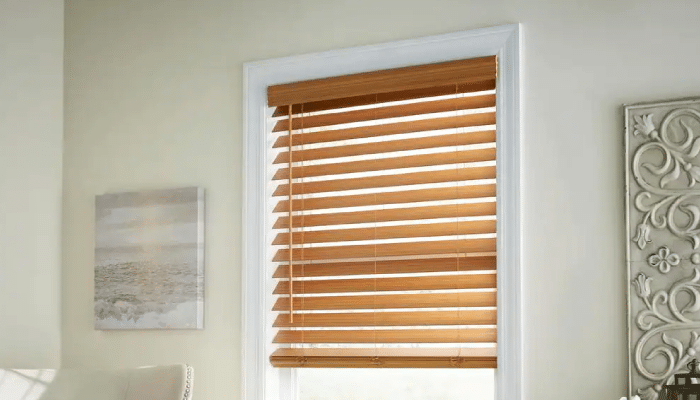Do you want to transform the look of your home? Window blinds can be one of your preferred choices. But how would you know faux blinds vs. wood blinds– which one should you choose?

While each has advantages, it is recommended to consider a variety of aspects, such as the region’s climate, the room’s function, and any requirements. For example, window coverings installed in rooms with high humidity levels, such as bathrooms and kitchens, should naturally be able to tolerate moisture.
Let’s have a deeper look at Faux Wood Blinds vs. Wood Blinds to help you choose the most suitable one for you.
What Are Wooden Blinds & A Good Idea?
Wooden blinds are made of real wood. It is available in different styles, including Venetian, vertical, and horizontal, and can be customized to fit any window size and is commonly used in residential and commercial settings.

One of the key features of wood blinds is their natural, warm appearance. They come in various colors and finishes to go with the décor and may add a sense of sophistication to a room.
Wood blinds are also highly durable and long-lasting, making them a good investment for homeowners. They can be easily stained or painted to change the color if desired.
There are several benefits to using wood blinds. In addition to their aesthetic appeal, they offer excellent light control and privacy and can help to insulate a room, reducing energy costs.
Wood blinds are popular for those looking for a natural, high-quality window treatment option. While they may be more expensive than other types of blinds, they are a long-lasting investment that can add value to a home.
Pros:
- Durable and long-lasting
- Aesthetic look
- Natural Insulation
Cons:
- Little Expensive
- Not efficient for high humidity area
What Are Faux Wood Blinds?
Faux wood blinds are designed to mimic the look of real wood. They are made from a composite material that is resistant to moisture and fading, making them a good choice for humid environments.

Faux wood blinds are also typically more affordable than real wood blinds, making them a popular choice for those on a budget.
Faux wood blinds can be adjusted, just like real wood blinds, to control the amount of light and privacy in space. They can be made to fit any window size and come in a variety of colors and styles. Faux wood blinds are also relatively easy to install and maintain and can be easily wiped clean with a damp cloth.
One of the key benefits of faux wood blinds is their resistance to warping and discoloration. Unlike real wood blinds, they are not affected by humidity and will not fade or discolor over time. This makes them a good choice for areas of the home that are prone to high levels of moisture, such as bathrooms and kitchens.
Faux wood blinds are also more environment friendly than real wood blinds, as they do not require cutting trees to produce. However, they are generally not as durable as real wood blinds and may not last as long over time.
Faux wood blinds are a popular choice for those looking for a budget-friendly window treatment option that is easy to maintain and resistant to moisture. While they may not have the same level of durability as real wood blinds, they offer a high-quality look at a more affordable price point.
Pros:
- Wood-Like Appearance
- Durable & Moisture Resistant
- Easy to maintain
- Eco-friendly
Cons:
- Less durable
What’s The Difference Between Faux Wood And Wood Blinds?
Window coverings have an outer look impact on your home. You should consider the size of the windows in your building space before choosing between real wood blinds and imitation wood blinds.
The material they are made of distinguishes real wood from faux wood. Wood blinds can be painted and painted in a number of ways to complement the design of your space. Because they are lighter than faux wood, wood blinds are preferable for large windows. Wood is not advised for high-humidity areas like bathrooms or kitchens because it might warp or crack.
| Faux Wood Blinds | Wood Blinds |
| High-Quality Look | Natural, Warm Appearance |
| Budget-Friendly | Little Expensive |
| Humidity Resistant/Resistant To Moisture And Fading | Less Resistance To Humidity |
| Less Durable | Highly Durable, And Long-Lasting, |
| Easier To Install | Less Easy To Install |
| Suitable For Moist Areas Like Bathrooms And Kitchens | Less Suitable For Moist Area |
| Easier To Maintain | Less Easy To Maintain |
| Environmentally Friendly |
Factors to consider when choosing between wood blinds and faux wood blinds

When choosing between wood blinds and faux wood blinds, it’s important to consider your budget, the decor of the room, and the level of durability and maintenance you are willing to commit to.
Wood blinds may be the best choice if you want a natural, long-lasting option with a high-end look. If you are looking for a more budget-friendly option that is easier to maintain, faux wood blinds may be a better fit.
The choice ultimately gets down to personal preference and the unique needs of your house.
Expert Opinion for choosing your blinds
Though faux wood blinds and wood blinds both appear similar, they have their own characteristics. Like faux wood blinds are more moisture-resistant than wood blinds.
Wood blinds may not be a good choice for the kitchen or bathroom, but they can be perfect for your living room or bedroom. If you want to match the decor of your home, think about choosing custom wood blind vanes with painted, rustic, or stained finishes.
Conclusion
Both wood blinds and faux wood blinds offer a number of benefits and can be a good choice for your home, depending on your specific needs and preferences. Wood blinds are made from real wood and offer a natural, warm look that can add a touch of sophistication to any room, whereas Faux Wood blinds are more affordable and more resistant to warping and discoloration than wood blinds.
If you still can not decide, book a consultation with Empire Windows Treatment to find the best solution for you.
FAQ
Are faux wood blinds more expensive than wood blinds?
Yes, wood blinds are comparatively more expensive than faux wood blinds. They may cost several hundred dollars more, depending on the size and quality.
Are faux wood blinds worth it?
Of course, comparatively, faux wood blinds are more humidity resistant and easy to maintain than real wood.
What are faux wood blinds made of?
Faux wood blinds are made of durable polymer materials like composite, PVC, vinyl, or foam wood.

